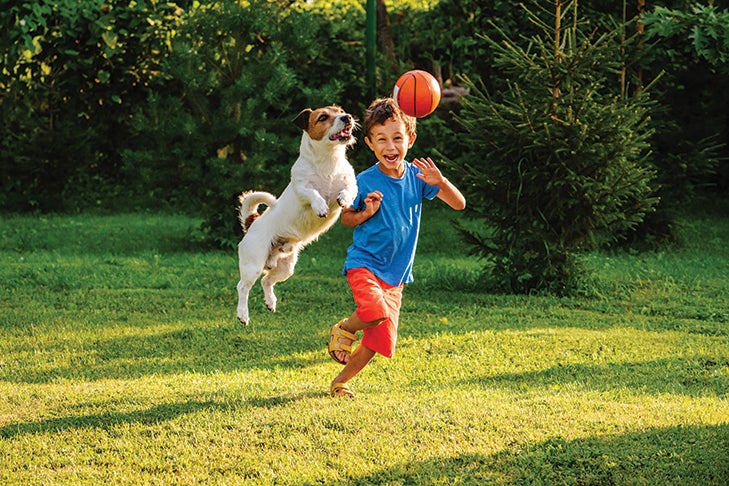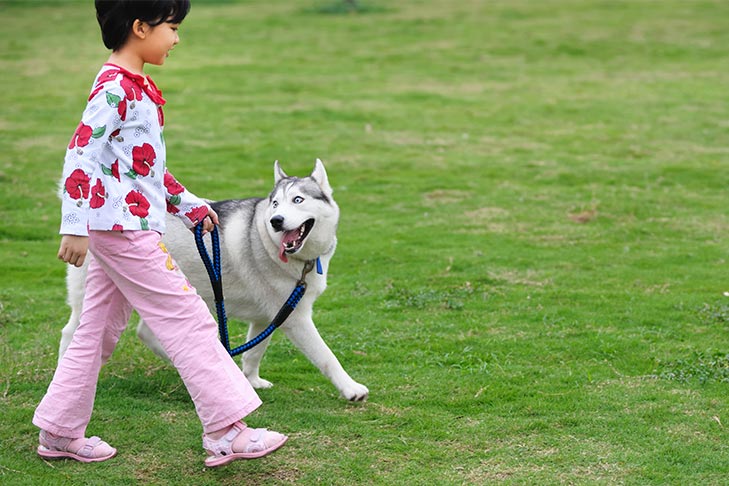
Whether you remember Petey from The Little Rascals, Lassie and Timmy, Benji, Beethoven, or Clifford the Big Red Dog, images of kids hugging and kissing dogs are burned into our minds.
For dog trainers, that imagery makes us cringe. We’ve seen some of the painful results of such interactions in real life—the kinds that won’t make it onto a movie screen.
At my dog-training school, we constantly caution parents against leaving dogs and kids together without supervision. We also emphasize another, more subtle point: Supervision doesn’t help if the adults don’t know how to interpret what they are seeing. It is almost as bad as no supervision at all.
Then the parental protests begin. “But I got the dog for my kid! And all I’m hearing is how they’re not supposed to interact. What can they do?”
As a parent myself, I understand.
And, as a former child, I warmly remember teaching Teddy, my Great Pyrenees, how to sit up, spin, beg, and jump through a hula hoop. (Although when she reached adult size, I taught her to sit in the hoop, which I placed on the ground.) My friends thought I was super cool. Their parents said I should become a dog trainer.
Early on, I learned a valuable lesson: There are safe ways for dogs and kids to enjoy their time together. It just takes some common sense and supervision.
Pay to Play
“Will work for food” must have been a phrase written by a dog. Most will eagerly offer all kinds of behaviors to the person, old or young, who is holding a treat. But make sure your child doesn’t give up the goods when your dog is doing something you don’t want him to do. A cautionary tale: My student’s toddler would succumb to an uncontrollable case of the giggles whenever their spaniel barked at him. If her son happened to be in his highchair at the time, he would rain food down onto the dog, which of course, rewarded the barking.

Remember
Children and dogs must be supervised. Also, learn general signs of canine stress, such as yawning, lip licking, and changes in their eyes and ears. If you see these signals, it may mean the dog is losing patience with the child and it is time to intervene.
Here’s a short list of activities that can be fun for your children (even very young ones!), your dogs, and you.
1. Take a Walk
You can hold one leash attached to the dog’s primary training collar, head halter, or body harness. Your child can hold a second leash attached to a second collar. I prefer a flat buckle collar. Yes, I know your dog usually wears only one collar, but for this exercise, add another! That way, you have control, and your child has the experience and pride in performing the vital task of walking the dog.
2. Fetch
This is a fun game for both kids and dogs. It’s high-energy, so it has the added benefit of giving the dog much-needed exercise as he runs back and forth to fetch the toy and return it. As the game progresses, the child can add commands like sit-stay before throwing the toy.
Make sure you keep it all under control to avoid mishaps, like a dog knocking the child down as he runs for the ball or “tugging” too aggressively when returning the toy.
(Pro tip: Teaching your dog mouth manners, like the drop it command, comes in handy here.)
3. Teach a Trick
Nothing is more fun or impressive than a dog who can shake, roll over, speak, or perform other cute moves. Teach your dog a few basic tricks, with or without your child’s help.
There are dozens to choose from. You can find step-by-step instructions through online educational resources, such as the AKC Trick Dog program’s library of training videos.
4. Search, Rescue, Treat
My kids loved to play this game when they were little. They’d hide (and have a really fabulous food reward with them), and I would send the dog to find them. When our dog sniffed out their hiding spot, the children would stand up, ask him to sit, and give him the treat. Their giggling may have given their location away, but no matter. Everyone had a good, fun, and safe time, which is, after all, why you got a dog in the first place.
Kathy Santo trains dogs for home and competition at her New Jersey school. She is the author of Kathy Santo’s Dog Sense and has handled multiple obedience trial champions.
Originally ran in the May/June 2020 issue of AKC Family Dog


